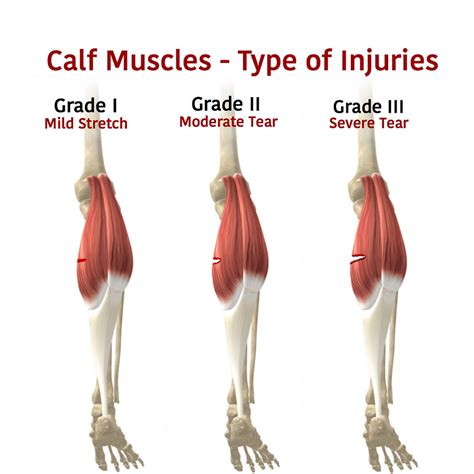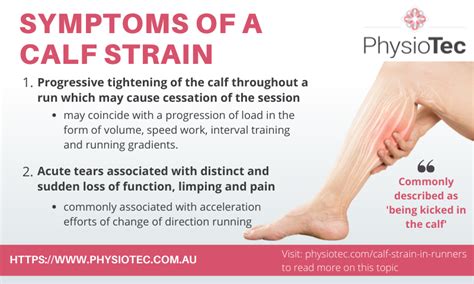Intro
Discover the difference between calf strain and calf tear, two common yet distinct leg injuries. Learn about symptoms, causes, and treatment options for calf strain vs tear, including muscle pulls, partial tears, and complete ruptures. Understand how to diagnose and recover from these injuries to get back on track.
Calf strains and tears are two common injuries that affect the muscles in the lower leg. While they share some similarities, they are distinct conditions with different severity levels and treatment options. Understanding the differences between a calf strain and a tear can help you seek proper medical attention and develop an effective recovery plan.
The calf muscles, comprising the gastrocnemius and soleus, play a crucial role in ankle movement, balance, and overall lower leg function. These muscles are prone to injury, especially in individuals who engage in sports or activities that involve running, jumping, or quick changes of direction. A calf strain or tear can be a debilitating injury, causing pain, swelling, and limited mobility.
What is a Calf Strain?

A calf strain is a mild to moderate injury that occurs when the muscle fibers in the calf are stretched or pulled. This can happen due to sudden contractions, overstretching, or repetitive stress on the muscle. Calf strains are often classified into three grades:
- Grade 1: Mild strain with minimal pain and limited loss of function
- Grade 2: Moderate strain with noticeable pain and some loss of function
- Grade 3: Severe strain with significant pain and substantial loss of function
Symptoms of a calf strain may include:
- Pain or tenderness in the calf muscles
- Swelling or bruising
- Limited ankle mobility
- Weakness or fatigue in the affected leg
Treatment for Calf Strain
Treatment for a calf strain typically involves the RICE principle:
- Rest: Avoid activities that aggravate the injury
- Ice: Apply ice packs to reduce pain and inflammation
- Compression: Use compression bandages or wraps to support the affected area
- Elevation: Elevate the affected leg to reduce swelling
In addition to the RICE principle, your healthcare provider may recommend physical therapy, stretching exercises, or pain medication to manage symptoms.
What is a Calf Tear?

A calf tear, also known as a calf rupture, is a more severe injury that occurs when the muscle fibers in the calf are completely torn. This can happen due to a sudden, forceful contraction or a direct blow to the muscle. Calf tears can be further classified into two types:
- Partial tear: A incomplete tear of the muscle fibers
- Complete tear: A complete rupture of the muscle fibers
Symptoms of a calf tear may include:
- Severe pain or a popping sensation in the calf muscles
- Swelling or bruising
- Significant weakness or loss of function in the affected leg
- Difficulty walking or standing
Treatment for Calf Tear
Treatment for a calf tear usually requires more aggressive interventions, including:
- Immobilization: Using a cast, splint, or walking boot to stabilize the affected area
- Physical therapy: A rehabilitation program to restore strength, flexibility, and range of motion
- Pain management: Medication or injections to manage pain and inflammation
- Surgery: In some cases, surgical repair may be necessary to reattach the torn muscle fibers
It's essential to seek medical attention promptly if you suspect a calf tear, as delayed treatment can lead to further complications and prolonged recovery.
Key Differences Between Calf Strain and Tear

The primary differences between a calf strain and a tear are:
- Severity: A calf strain is a milder injury, while a calf tear is a more severe condition.
- Symptoms: A calf strain typically presents with mild to moderate pain, while a calf tear is characterized by severe pain and significant loss of function.
- Treatment: Calf strains can often be treated with conservative measures, while calf tears may require more aggressive interventions, including surgery.
Preventing Calf Strains and Tears
While it's impossible to completely eliminate the risk of calf injuries, there are steps you can take to reduce your likelihood of developing a strain or tear:
- Warm up and stretch before exercise or physical activity
- Wear proper footwear and use orthotics if necessary
- Gradually increase intensity and duration of exercise or physical activity
- Strengthen your calf muscles through targeted exercises
- Listen to your body and rest when experiencing pain or discomfort
By understanding the differences between a calf strain and a tear, you can take proactive steps to prevent these injuries and seek proper medical attention if you do experience a calf injury.
Conclusion
Calf strains and tears are common injuries that can have a significant impact on your daily life. While they share some similarities, it's essential to understand the differences between these two conditions to develop an effective treatment plan. By recognizing the symptoms, severity, and treatment options for each condition, you can take the first step towards a successful recovery.
What is the difference between a calf strain and a calf tear?
+A calf strain is a mild to moderate injury that occurs when the muscle fibers in the calf are stretched or pulled, while a calf tear is a more severe injury that occurs when the muscle fibers are completely torn.
What are the symptoms of a calf strain?
+Symptoms of a calf strain may include pain or tenderness in the calf muscles, swelling or bruising, limited ankle mobility, and weakness or fatigue in the affected leg.
How can I prevent calf strains and tears?
+To prevent calf strains and tears, warm up and stretch before exercise or physical activity, wear proper footwear, gradually increase intensity and duration of exercise, strengthen your calf muscles, and listen to your body and rest when experiencing pain or discomfort.
